In 1821, Carl Christian Friedrich Glenck was prompted by clues to start prospecting for salt in north-western Switzerland. And he found what he was looking for near the "Red House" in Muttenz in 1836. Due to differences with the owners of land surrounding the deposit, he founded his own company – Saline Glenck, Kornmann & Co.– in 1837. But he was not the only one in search of salt. Two more saltworks were established in about 1841: the "Saline Kaiseraugst" and the "Saline Rheinfelden". In 1909, the merger of the individual saltworks based in north-western Switzerland resulted in the formation of "Schweizer Rheinsalinen AG". Finally, this company merged with Saline de Bex SA in 2014 to become "Schweizer Salinen AG". Since then, Schweizer Salinen AG has been extracting salt to meet people's many different needs.
There are basically three different types of salt: evaporated salt, sea salt and rock salt. All the varieties of salt are obtained by different methods and with the use of different equipment. Schweizer Salinen AG uses the evaporation method to obtain salt. At its Schweizerhalle, Riburg and Bex sites, Schweizer Salinen AG leaches salt out of the rock salt layers at depths of as much as 400 m by feeding in water. The concentrated salt solution flows through pipelines to the drilling field collection tank, from where it is transported to the saltworks for softening and to undergo the crystallisation process in the evaporator plant. The salt solution (brine) used to be "boiled up" in large pans. The salt obtained in this way was therefore known as "cooked" or "evaporated" salt. These traditional terms have remained in use (in German) through to modern times. The brine is stored in the newly constructed raw brine tanks in order to optimise the production processes. Raw brine is essentially water with a high content of salt. But because of this salty water, the steel tanks must have a special coating to prevent the metal from starting to decompose due to oxidation. In 2020, two new tanks with overall heights of 24 m and diameters of 14 m were built by Josef Muff AG at Schweizer Salinen AG's site in Rheinfelden. Tanks with such large dimensions cannot be manufactured in one single piece. They are welded stage by stage and assembled on site.
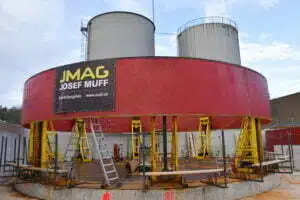
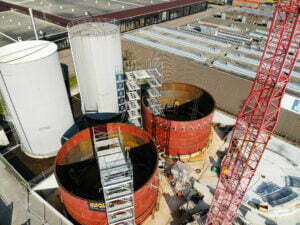
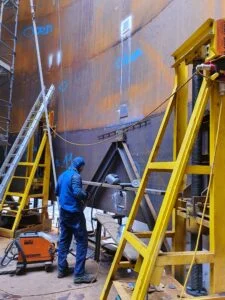
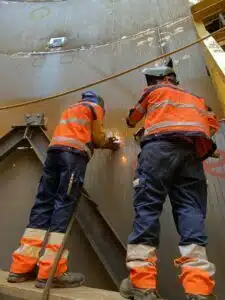
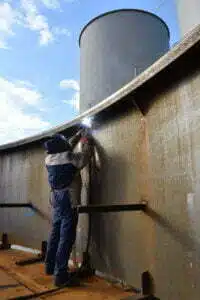
The greatest challenges presented by this project were the tight schedule and the fact that assignments such as these are very rare. The tank construction sector is very small and there are only a few jobs of this size. A former employee of Josef Muff AG stated that he was prepared to participate by providing support for this assignment and to share his knowledge so that know-how is also safeguarded for the future. Based on the planning for the project, the execution period would be just under 23 weeks. Thanks to collaboration among all Josef Muff AG's teams, optimal use was made of the narrow time window for the installation and the completion deadline was met.
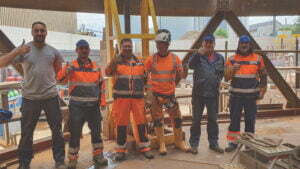
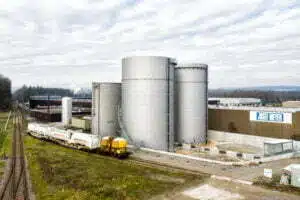
Another unusual feature of this contract was the high quality standard required for the coating. The inner and outer coatings were provided by BETOSAN AG, an experienced coating company that is thoroughly familiar with the behaviour of salt and its potential for tank corrosion. After consultation with the client, the optimal state-of-the-art coating was selected and applied.
Coating report by BETOSAN AG
The first discussion with Rapp Infra AG's engineers and construction managers made it clear that everyone spoke the same language. This meant that procedures could be optimised and technical difficulties could already be eliminated during the preliminary discussions. Thanks to BETOSAN AG's experience of tank coatings, it was possible to take an individual approach in order to meet Schweizer Salinen AG's requirements. Schweizer Salinen AG's two raw brine tanks have an unusual feature compared to other vertical tanks of this size: they do not have roofs, so they are open at the top. This made it difficult to install scaffolding for the work both inside and outside the tanks, including a special emergency roof to protect against wind and weather conditions.
When evaluating the coating product to be applied on the inside of the tanks, another unusual requirement had to be considered in addition to technical aspects such as resilience, a certificate of conformity for food contact and very thick coatings: it had to be guaranteed that the product would be workable and would dry out at a minimum temperature of 10 degrees Celsius. This hurdle was also overcome in collaboration with an international manufacturer, and work on the coating could now begin.
Like Josef Muff AG, we also had to cope with a tight timeframe. Thanks to the support of our well-trained specialist staff, we were able to apply the interior coating in a few days while temperatures were still moderate. Additional heating of the tanks meant that the lower temperatures at night were no longer an issue. All the key parameters for the coating structure and climate conditions were met, and the interior coating was ultimately handed over on schedule.
The multiple outer coating layers were applied in parallel with the preliminary work on the inner coating. The high August temperatures stretched both the staff and the coating materials to their limits. This also led to a situation where our staff were already starting work on the scaffold at five o'clock in the morning. Despite all the unusual circumstances, the work was completed professionally and safely.